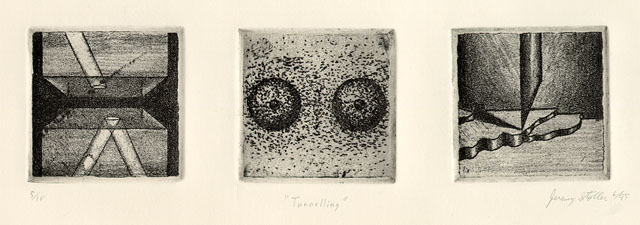This
print depicts three different examples of a phenomenon known
as quantum tunneling. When a particle is trapped by
a barrier, which it does not have enough energy to penetrate,
there is a finite chance that particle will somehow "tunnel" through
the barrier anyway. Imagine a marble rolling around the bottom
of a bowl. Assume that this marble only has enough energy
to roll half way up the side of the bowl. The quantum tunneling
phenomenon predicts that there is a chance that the marble
will suddenly appear on the outside of the bowl. In actuality,
the probability of this happening with any macroscopic object,
like a marble, is negligibly low. However, the theory is
quite sound.
The central image in the print depicts electron
tunneling. An electron orbiting an atom is analogous
to the marble rolling around the bowl. There is a 90% chance
that the electron will be found within its orbit shell,
but that other 10% of the time the electron tunnels out
side of its allowed orbit and can be anywhere else in the
universe. The probability of a particle tunneling to a
particular point falls off exponentially with distance
however, so the electron is likely to found near (if not
in) its atom. The image shows two atoms close to one another,
so that electrons from one atom are likely to tunnel over
to the other atom. The density of black in the image is
analogous to the probability density of finding the electron.
The right hand image depicts the
tip of a Scanning Tunneling Microscope, or STM, scanning
a sample. This Nobel prize winning microscope uses the electron
tunneling phenomena to image metallic substances on an atomic
level. It does this by passing an extremely sharp wire tip
within an atom's width of the sample, and monitoring the
current created by electrons tunneling between the tip and
the sample.
The left hand image depicts the tunneling
of photons (particles of light), known as frustrated internal
reflection. If you shine light through a piece of glass,
when it reaches the surface some of the light will pass through,
and some of the light will be reflected back into the glass.
The amount of the light which gets reflected depends on the
angle at which the light hits the surface of the glass. For
any frequency of light, there is one critical angle at which
all of the light is reflected. This is known as total internal
reflection. If, however, you place a second piece of glass
very close to the surface of the first, then some of the
light will tunnel through the barrier between the two surfaces,
and continue traveling through the second piece of glass,
even at that critical angle. This is frustrated internal
reflection.
|
 |
 |

![]()
